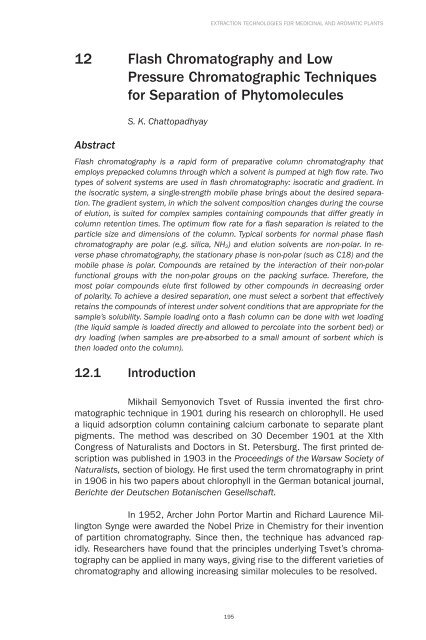Extraction Technologies For Medicinal And Aromatic Plants - Unido
Extraction Technologies For Medicinal And Aromatic Plants - Unido
Extraction Technologies For Medicinal And Aromatic Plants - Unido
You also want an ePaper? Increase the reach of your titles
YUMPU automatically turns print PDFs into web optimized ePapers that Google loves.
EXTRACTION TECHNOLOGIES FOR MEDICINAL AND AROMATIC PLANTS<br />
12 Flash Chromatography and Low<br />
Pressure Chromatographic Techniques<br />
for Separation of Phytomolecules<br />
Abstract<br />
S. K. Chattopadhyay<br />
Flash chromatography is a rapid form of preparative column chromatography that<br />
employs prepacked columns through which a solvent is pumped at high fl ow rate. Two<br />
types of solvent systems are used in fl ash chromatography: isocratic and gradient. In<br />
the isocratic system, a single-strength mobile phase brings about the desired separation.<br />
The gradient system, in which the solvent composition changes during the course<br />
of elution, is suited for complex samples containing compounds that differ greatly in<br />
column retention times. The optimum fl ow rate for a fl ash separation is related to the<br />
particle size and dimensions of the column. Typical sorbents for normal phase fl ash<br />
chromatography are polar (e.g. silica, NH2) and elution solvents are non-polar. In reverse<br />
phase chromatography, the stationary phase is non-polar (such as C18) and the<br />
mobile phase is polar. Compounds are retained by the interaction of their non-polar<br />
functional groups with the non-polar groups on the packing surface. Therefore, the<br />
most polar compounds elute fi rst followed by other compounds in decreasing order<br />
of polarity. To achieve a desired separation, one must select a sorbent that effectively<br />
retains the compounds of interest under solvent conditions that are appropriate for the<br />
sample’s solubility. Sample loading onto a fl ash column can be done with wet loading<br />
(the liquid sample is loaded directly and allowed to percolate into the sorbent bed) or<br />
dry loading (when samples are pre-absorbed to a small amount of sorbent which is<br />
then loaded onto the column).<br />
12.1 Introduction<br />
Mikhail Semyonovich Tsvet of Russia invented the fi rst chromatographic<br />
technique in 1901 during his research on chlorophyll. He used<br />
a liquid adsorption column containing calcium carbonate to separate plant<br />
pigments. The method was described on 30 December 1901 at the XIth<br />
Congress of Naturalists and Doctors in St. Petersburg. The fi rst printed description<br />
was published in 1903 in the Proceedings of the Warsaw Society of<br />
Naturalists, section of biology. He fi rst used the term chromatography in print<br />
in 1906 in his two papers about chlorophyll in the German botanical journal,<br />
Berichte der Deutschen Botanischen Gesellschaft.<br />
In 1952, Archer John Portor Martin and Richard Laurence Millington<br />
Synge were awarded the Nobel Prize in Chemistry for their invention<br />
of partition chromatography. Since then, the technique has advanced rapidly.<br />
Researchers have found that the principles underlying Tsvet’s chromatography<br />
can be applied in many ways, giving rise to the different varieties of<br />
chromatography and allowing increasing similar molecules to be resolved.<br />
195

















